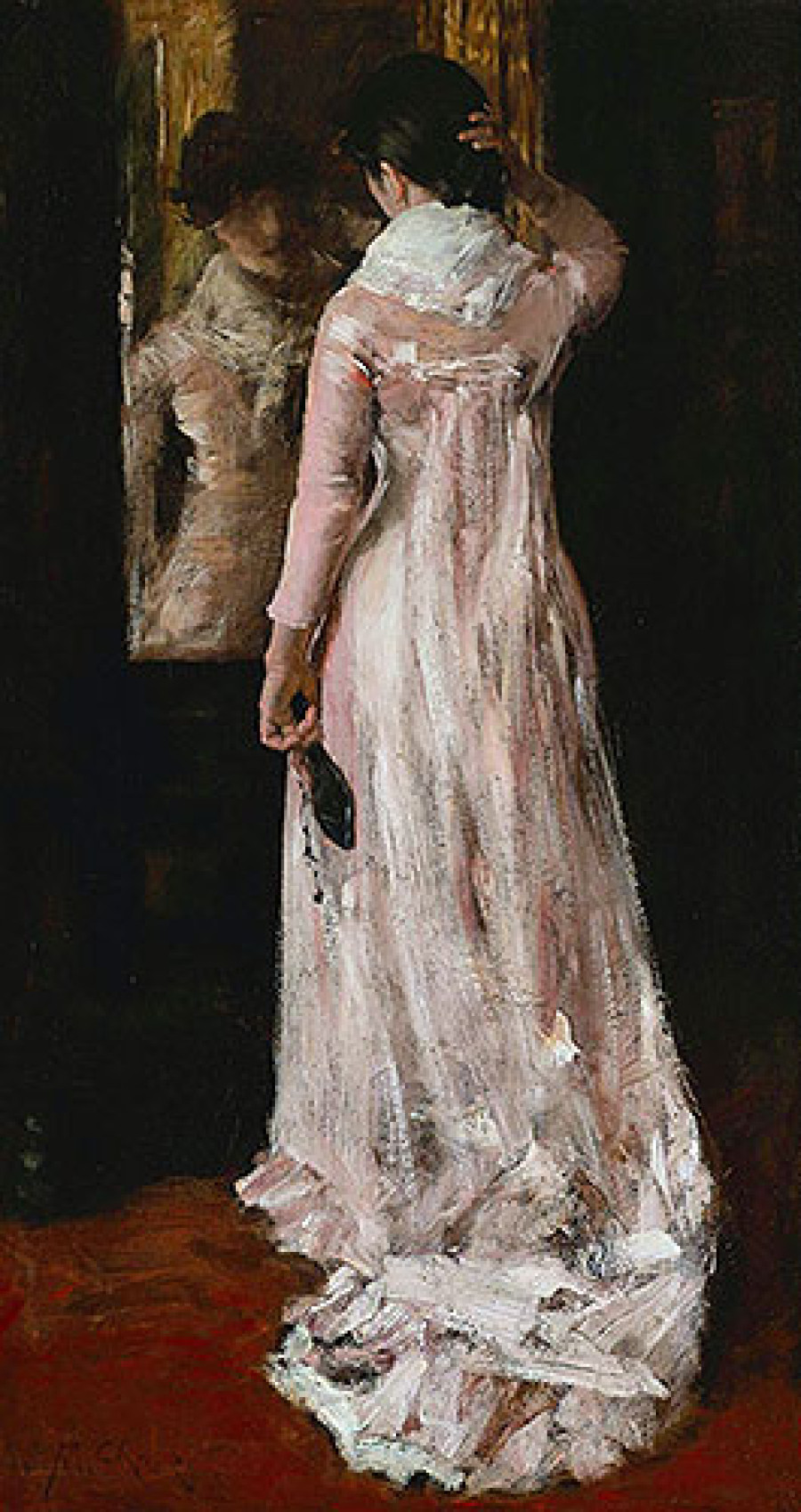Uncovering Art History
“I Think I Am Ready Now”, by painter William Merritt Chase
06 Mar 2025

William Merritt Chase, one of the 19th century’s most prominent American painters, is known as an exponent of Impressionism and a teacher. He also established the Chase School, which later would become Parsons School of Design.
He mostly worked in oil and pastel, but also created watercolor paintings and etchings. S.G.W. Benjamin said of his style in a contemporary review: “A noble sense of color is perceptible in all his works, whether in the subtle elusive tints of flesh, or in the powerful rendering of a mass of scarlet, as in his notable painting of the "Court Jester". In the painting of a portrait he endeavors, sometimes very successfully, to seize character, although occasionally rather too impressionist in style.”
Born in Indiana, Chase’s family moved to Indianapolis where he worked for his small family business. He studied art and after joining and then leaving the US Navy, Chase was encouraged by his art teachers to train as an artist in New York at the National Academy of Design. He was sponsored to travel to Europe for two years and went to study in Munich. After an extended trip to Venice, with fellow American artist John Henry Twatchman, Chase returned to New York, married and began to teach. He was a good friend of Winslow Homer, and following the success of his studio in New York he opened a summer school in the Shinnecock Hills on Long Island, near his summer home.
Chase was very influential amongst American Impressionist painters, not only due to his own work, but because of the artists he trained. George Bellows, Georgia O’Keeffe, Edward Hopper, Charles Demuth, and Rockwell Kent were all his students. His Chase School of Art became the New York School of Art, and Chase also taught at the Pennsylvania Academy of the Fine Arts and at the Brooklyn Art Association. He became a member of the group of Group of Ten also known as Ten American Painters after John Henry Twatchman died.
W.M. Chase portrait painting
He is perhaps best known for his portraits, and his models including some of the most important men and women of his time. Chase also frequently painted his wife Alice and their children, sometimes in individual portraits, and other times in scenes of domestic tranquility: at breakfast in their backyard, or relaxing at their summer home on Long Island, the children playing on the floor or among the sand dunes of Shinnecock. In an 1895 painting titled A Friendly Call, his wife is depicted wearing a yellow dress and entertaining a caller dressed in white.
William Chase painted in the Impressionist style and he was influenced by The French Impressionist Exhibition of 1886 which the French art dealer Durand-Ruel brought to New York. The last summer class conducted by William Merritt Chase at the art school at Carmel by the Sea, in California, in 1914, where he had a record attendance of over 100 pupils.
Chase portraits were of prominent and wealthy people of the day, as well as the many less formal paintings of his wife and eight children. Famous American paintings by William Merritt Chase are Afternoon in the Park 1890, Spring Flowers Peonies 1889, Portrait of Miss Dora Wheeler 1883, and Portrait of a Lady.
Merrit Chase also painted still life. His main subject was dead fish which he frequently painted against a dark background. Discover art reproductions on canvas of Still Life with Fish 1908 from our standard catalogue. William Merritt Chase famous still life oil paintings include Still Life with Fruit and Pitcher and Autumn Fruit 1871.
Any subject could be made beautiful, declared Chase, but it was how that subject was painted and not what that subject represented that mattered most. With this in mind, the question of content is a fascinating one in the art of Chase. Without doubt, Chase sought to avoid the trite sentimentality or the staid quality of a fixed narrative that would grow old and lose its hold on the viewer. Perhaps with this motivation in mind, it is not surprising to find that in many of Chase’s finest interiors, he often instills a sense of drama, mystery, or ambiguity into the scene.
The painting “I Think I Am Ready Now” (or The mirror / The pink Dress, 1883; private collection), is showing a woman in a pink dress before a mirror holding a hair brush in one hand and fixing her hair with the other. Darkness surrounds her suggestive form conjured out of thick brush strokes that mesmerize us as they reach a dramatic flourish in the abstract train of her dress. With her back turned, we encounter the subject from behind, glimpsing her face only through its reflection in the mirror. Through the title, Chase conjures an imagined dialogue between the subject and the unseen protagonist (the artist) who hovers outside the frame.
Chase won many honors at home and abroad, was a member of the National Academy of Design, New York, and from 1885 to 1895 was president of the Society of American Artists. He became a member of the Ten American Painters after John Henry Twachtman died. Today his works are in most major museums in the United States. His home and studio at Shinnecock Hills, New York, was added to the National Register of Historic Places in 1983 as the William Merritt Chase Homestead.
By Cosmina M Oltean
(Art writer & PPG Gallery curator)
All news